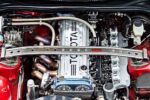Chevy 6.2 Engine: A Brief Overview
The Chevy 6.2 engine, part of General Motors’ family of small-block V8 engines, has been a significant player in the automotive landscape since its introduction. Launched in the early 2000s, this engine was designed to provide a balance of power and efficiency, making it a popular choice for a range of vehicles, from trucks to performance cars. The 6.2-liter variant, known for its robust performance and towing capabilities, quickly gained a reputation among enthusiasts and everyday drivers alike.
Evolution and Popularity
Over the years, the Chevy 6.2 engine has undergone several updates and refinements, enhancing its performance and reliability. It has been featured in various models, including the Chevrolet Silverado, GMC Sierra, and the iconic Corvette. The engine’s design incorporates advanced technologies such as variable valve timing and direct fuel injection, aimed at maximizing power output while minimizing fuel consumption.
Despite its popularity, the 6.2 engine is not without its issues. As with any mechanical component, wear and tear, manufacturing defects, and design flaws can lead to problems that may affect performance and longevity. Understanding these potential issues is crucial for current and prospective owners, as they can impact not only the driving experience but also safety and maintenance costs. This article will delve into the common problems associated with the Chevy 6.2 engine, providing a straightforward analysis of what owners need to know.
Common Issues with the Chevy 6.2 Engine
The Chevy 6.2 engine has garnered a loyal following due to its impressive power and versatility. However, like any engine, it is prone to specific problems that can arise over time. Understanding these issues is essential for maintaining the engine’s performance and longevity.
1. Oil Consumption Issues
One of the most frequently reported problems with the Chevy 6.2 engine is excessive oil consumption. This issue can manifest in several ways:
- Increased oil levels in the engine.
- Oil leaks around seals and gaskets.
- Blue smoke from the exhaust, indicating burning oil.
Excessive oil consumption can lead to serious engine damage if not addressed promptly. Owners should monitor oil levels regularly and be vigilant for any signs of leaks or smoke.
2. Timing Chain Problems
The timing chain in the Chevy 6.2 engine is critical for synchronizing the engine’s internal components. Over time, wear and tear can lead to several issues:
- Chain stretch, resulting in poor engine performance.
- Timing chain noise, indicating potential failure.
- Engine misfires due to improper timing.
If the timing chain fails, it can cause catastrophic engine damage. Regular inspections and timely replacements are crucial to avoid this problem.
3. Fuel Injector Failures
Fuel injectors are responsible for delivering fuel to the engine. In the Chevy 6.2, injector failures can lead to:
- Reduced engine performance and power.
- Increased fuel consumption.
- Engine stalling or rough idling.
Cleaning or replacing faulty fuel injectors can restore performance, but neglecting this issue can lead to more severe engine problems.
4. Overheating Issues
Overheating is a significant concern for any engine, including the Chevy 6.2. Common causes of overheating include:
- Coolant leaks from hoses or the radiator.
- Faulty thermostat preventing proper coolant flow.
- Clogged coolant passages.
Overheating can cause severe damage to engine components, including warped heads and blown gaskets. Regular maintenance of the cooling system is essential to prevent this issue.
5. Cylinder Head Gasket Failures
Cylinder head gasket failures can lead to a host of problems, including:
- Coolant mixing with engine oil.
- Loss of engine compression.
- Overheating due to coolant loss.
This issue can be costly to repair, making early detection vital. Signs of a failing head gasket include white smoke from the exhaust and a milky appearance in the oil.
Top views |
|
|---|---|
 |
Oil, Timing Chains, Pistons: What Really Kills an Engine Prematurely? |
 |
How to Choose a Car with a Reliable Engine: Used Car Market Hacks That Actually Work |
Symptoms and Consequences
Understanding the symptoms associated with these problems can help owners take action before severe damage occurs. The following table summarizes common symptoms and their potential consequences:
| Symptom | Potential Consequence |
|---|---|
| Excessive oil consumption | Engine wear and potential failure |
| Timing chain noise | Engine misfires and damage |
| Rough idling or stalling | Reduced performance and efficiency |
| Overheating | Warped heads and blown gaskets |
| White smoke from exhaust | Head gasket failure and coolant loss |




0 Comments